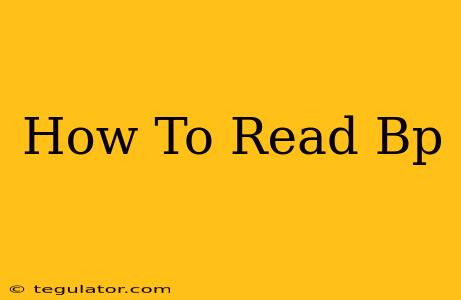Understanding your blood pressure reading is crucial for maintaining good health. High blood pressure, or hypertension, is a silent killer, often showing no symptoms until it's caused significant damage. Knowing how to interpret your blood pressure numbers empowers you to take control of your heart health. This guide provides a simple, step-by-step explanation of how to read blood pressure and what the numbers mean.
Understanding the Numbers: Systolic and Diastolic Pressure
A blood pressure reading consists of two numbers, expressed as a fraction (e.g., 120/80 mmHg). These numbers represent:
- Systolic Pressure (the top number): This measures the pressure in your arteries when your heart beats and pumps blood.
- Diastolic Pressure (the bottom number): This measures the pressure in your arteries when your heart rests between beats.
What Do the Numbers Mean? Blood Pressure Categories
Blood pressure is categorized into different levels, each carrying different health implications. Understanding these categories is vital for recognizing potential health risks. The categories are defined by the American Heart Association (AHA) and other health organizations:
- Normal: Less than 120/80 mmHg. This is the ideal blood pressure range.
- Elevated: Systolic between 120-129 and diastolic less than 80 mmHg. While not hypertension, it warrants monitoring and lifestyle changes.
- Stage 1 Hypertension: Systolic between 130-139 mmHg or diastolic between 80-89 mmHg. This indicates high blood pressure and requires medical attention.
- Stage 2 Hypertension: Systolic 140 mmHg or higher or diastolic 90 mmHg or higher. This requires immediate medical attention and often involves medication.
- Hypertensive Crisis: Systolic over 180 mmHg or diastolic over 120 mmHg. This is a medical emergency requiring immediate treatment.
Factors Affecting Blood Pressure Readings
Several factors can influence your blood pressure reading, making it crucial to understand them for accurate interpretation. These factors include:
- Time of Day: Blood pressure tends to be higher in the morning and lower in the evening.
- Activity Level: Physical activity temporarily raises blood pressure.
- Stress: Stress can significantly elevate blood pressure.
- Caffeine and Alcohol: These substances can temporarily increase blood pressure.
- Medications: Certain medications can affect blood pressure readings.
Getting an Accurate Reading
To obtain an accurate blood pressure reading, follow these guidelines:
- Rest for at least 5 minutes before the measurement.
- Avoid smoking or drinking caffeine or alcohol 30 minutes before.
- Sit with your back supported and your feet flat on the floor.
- Keep your arm at heart level.
- Ensure the cuff fits properly.
- Take multiple readings and average them.
When to See a Doctor
Regular blood pressure monitoring is essential, especially if you have risk factors for hypertension, such as family history, obesity, diabetes, or high cholesterol. If you have concerns about your blood pressure or consistently see readings outside the normal range, consult your doctor immediately. Early detection and management of high blood pressure are key to preventing serious health complications. Don't hesitate to seek professional medical advice. Your health is your greatest asset.
Beyond the Numbers: Lifestyle Changes for Healthy Blood Pressure
Maintaining a healthy blood pressure is not just about the numbers; it's about adopting a healthy lifestyle. Consider these key steps:
- Dietary Changes: Focus on a diet rich in fruits, vegetables, and whole grains, while limiting sodium, saturated fats, and processed foods. The DASH diet (Dietary Approaches to Stop Hypertension) is often recommended.
- Regular Exercise: Aim for at least 150 minutes of moderate-intensity aerobic activity per week.
- Stress Management: Practice relaxation techniques like yoga, meditation, or deep breathing exercises.
- Weight Management: Maintaining a healthy weight reduces strain on the cardiovascular system.
- Limit Alcohol Intake: Moderate alcohol consumption is generally recommended, but excessive drinking can raise blood pressure.
- Quit Smoking: Smoking damages blood vessels and increases blood pressure.
By understanding how to read your blood pressure and making conscious lifestyle changes, you can take proactive steps toward protecting your heart health. Remember, consistent monitoring and seeking professional guidance are crucial for maintaining optimal blood pressure and overall well-being.

